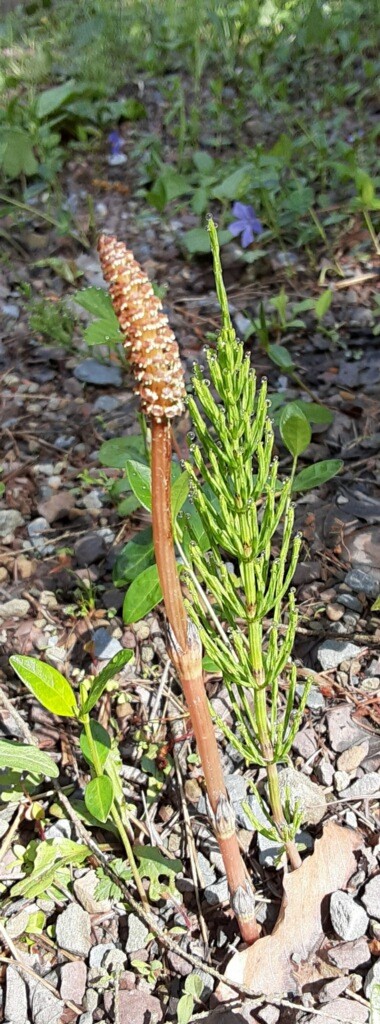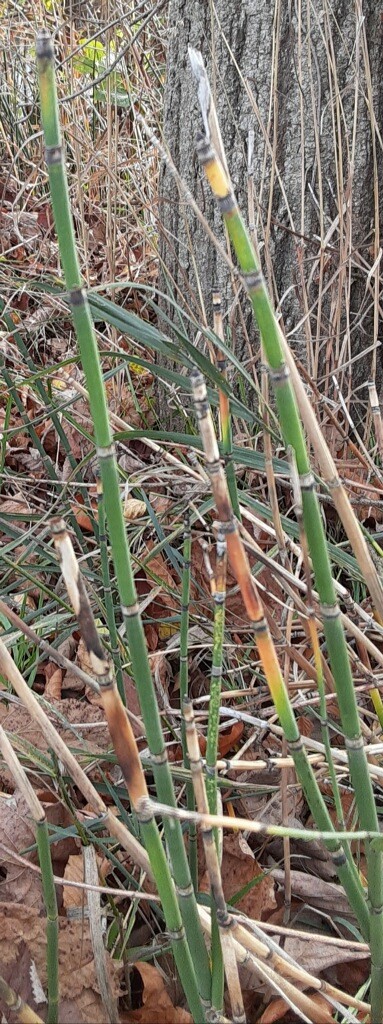By: Susan Sprout
People use the phrase “living fossil” to refer to living organisms that have a close similarity to extinct ones. Members of the same family and genus may have survived rather than the actual species. So it is with Horsetails of the genus Equisetum, the only living genus of the Horsetail Family, Equisetaceae. The fossilized imprints and stems of their Carboniferous progenitors, the sphenophytes, can be found in many of the Pennsylvania coal mines.
Today, way above those underground beds, and in all parts of the world except Australasia, there are fifteen different species of Horsetails living. Seven can be found in Pennsylvania. I have found two of the most common growing nearby. They are Field or Common Horsetail (E. arvense) and Scouring Rush (E. hyemale). They both look so very different from other herbaceous perennials found locally, that I’ve always been attracted by them.

In early spring, Field Horsetails grow from underground rhizomes, putting out a pink to brown fertile stem with a spore cone at the top. The green spores from it will disperse in the wind shortly before the stem withers. The yearly vegetative stems come next, looking like little trees with naked branches whirling around them similar to the spokes of umbrellas. A gentle stroke of the plant will tell you this plant isn’t a softie! it has a rough, sand-like surface that comes from the same mineral as sand. A mix of silicon dioxide and water from the soil is absorbed by roots and crystallized in the plant’s tissues. It has been observed in all parts of the plant – rhizome, stem, leaf and spores.

Yes, there are leaves, though not very obvious. They are projected as tiny teeth, their bottoms fused together as a sheath, making a dark stripe around the hollow stem directly above the branches. Look for Field Horsetails in wet meadows, along dirt roads in the woods (where I found mine), and open meadows.

Unlike Field Horsetails, Scouring Rush is unbranched and looks like a short bamboo forest when it emerges from the soil. Their jointed, hollow stems have dark bands where the tiny deciduous leaves are growing along them. Each shoot tip has a spore cone that will mature and release its spores to the wind from late spring to early summer. They are pretty hardy and can grow on stream banks (Muncy Creek on Chippewa Road), along railroad embankments, and roadsides. They seem to form colonies that spread a bit each year.

Horsetails were useful to many during the exploration and colonization history of the New World. The newcomers brought with them the knowledge of herbal remedies using horsetails that date back to the ancient Greeks and Romans who used the plants to stop bleeding, heal ulcers, and knit wounds. They were probably delighted to see them growing here for their use. The common name Scouring Rush indicates its use as a polishing material because it has the grit of a fine sandpaper. It was good for cleaning pots and pans way before the invention of Brillo pads. In a pinch, I have used them myself on black iron frying pans while camping. Yes, I forgot to pack the Brillo.


